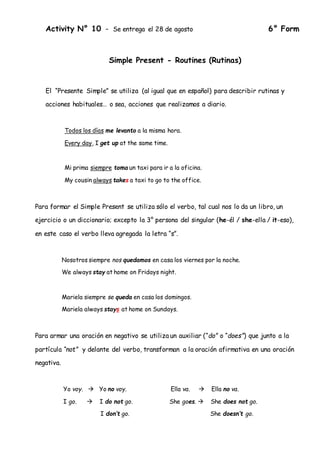Sexto grado activity 10
•Download as DOCX, PDF•
0 likes•496 views
SEXTO GRADO. MARCELA GRILLO. 18 DE AGOSTO 2O20. https://laescuelaenmicasa6de20.blogspot.com/p/ingles.html
Report
Share
Report
Share

Recommended
Recommended
More Related Content
What's hot
What's hot (20)
Using Direct & Indirect Object Pronouns in Spanish

Using Direct & Indirect Object Pronouns in Spanish
Similar to Sexto grado activity 10
Similar to Sexto grado activity 10 (20)
AMERICAN HEADWAY 3 VERSION 2003. Gramatica del libro.

AMERICAN HEADWAY 3 VERSION 2003. Gramatica del libro.
Guía de inglés para academia y exámenes para combinar

Guía de inglés para academia y exámenes para combinar
Guia Verb To Be Present Simple Alphabet Recoleta 2010

Guia Verb To Be Present Simple Alphabet Recoleta 2010
More from felipeboero1
More from felipeboero1 (20)
Matematica semana del 30 de noviembre al 4 de diciembre del 2020

Matematica semana del 30 de noviembre al 4 de diciembre del 2020
Matematica semana del 24 al 27 de noviembre de 2020

Matematica semana del 24 al 27 de noviembre de 2020
Recently uploaded
Diapositivas de mi seminario "Usos y desusos de la inteligencia artificial en revistas científicas", facilitado a editores de revistas científicas de Iberoamérica en el XIII Congreso Internacional sobre Revistas Científicas (CRECS 2024), el 8 de mayo de 2024 en la ciudad de Arequipa, Perú, en el campus de la Universidad Católica de Santa María.Usos y desusos de la inteligencia artificial en revistas científicas

Usos y desusos de la inteligencia artificial en revistas científicasJuan D. Machin-Mastromatteo #Juantífico
Recently uploaded (20)
Prueba de evaluación Geografía e Historia Comunidad de Madrid 4ºESO

Prueba de evaluación Geografía e Historia Comunidad de Madrid 4ºESO
PLAN LECTOR 2024 integrado nivel inicial-miercoles 10.pptx

PLAN LECTOR 2024 integrado nivel inicial-miercoles 10.pptx
Usos y desusos de la inteligencia artificial en revistas científicas

Usos y desusos de la inteligencia artificial en revistas científicas
Louis Jean François Lagrenée. Erotismo y sensualidad. El erotismo en la Hist...

Louis Jean François Lagrenée. Erotismo y sensualidad. El erotismo en la Hist...
Prueba libre de Geografía para obtención título Bachillerato - 2024

Prueba libre de Geografía para obtención título Bachillerato - 2024
RESOLUCIÓN VICEMINISTERIAL 00048 - 2024 EVALUACION

RESOLUCIÓN VICEMINISTERIAL 00048 - 2024 EVALUACION
PINTURA DEL RENACIMIENTO EN ESPAÑA (SIGLO XVI).ppt

PINTURA DEL RENACIMIENTO EN ESPAÑA (SIGLO XVI).ppt
Sexto grado activity 10
- 1. Activity N° 10 - Se entrega el 28 de agosto 6° Form Simple Present - Routines (Rutinas) El “Presente Simple” se utiliza (al igual que en español) para describir rutinas y acciones habituales… o sea, acciones que realizamos a diario. Todos los días me levanto a la misma hora. Every day, I get up at the same time. Mi prima siempre toma un taxi para ir a la oficina. My cousin always takes a taxi to go to the office. Para formar el Simple Present se utiliza sólo el verbo, tal cual nos lo da un libro, un ejercicio o un diccionario; excepto la 3° persona del singular (he-él / she-ella / it-eso), en este caso el verbo lleva agregada la letra “s”. Nosotros siempre nos quedamos en casa los viernes por la noche. We always stay at home on Fridays night. Mariela siempre se queda en casa los domingos. Mariela always stays at home on Sundays. Para armar una oración en negativo se utiliza un auxiliar (“do” o “does”) que junto a la partícula “not” y delante del verbo, transforman a la oración afirmativa en una oración negativa. Yo voy. Yo no voy. Ella va. Ella no va. I go. I do not go. She goes. She does not go. I don’t go. She doesn’t go.
- 2. Para hacer una pregunta también se usan los auxiliares “do” y “does”, que se colocan antes del sujeto de la oración. ¿Ustedes van al colegio juntos? ¿Tu mamá trabaja de noche? Do you go to school together? Does you mum work at night? ¿A qué hora te acostás todos los días? ¿Cómo viaja Roberto a su trabajo? What time do you go to bed every day? How does Robert go to work? Para responder en forma corta, o sea contestar sólo “sí” o “no” también se usan los auxiliares “do” o “does”. ¿Te gusta el pescado? Sí. ¿Ella sabe inglés? Sí. Do you like fish? Yes, I do. Does she speak English? Yes, she does. ¿Hablás francés? No. ¿Llueve mucho en verano? No. Do you speak French? No, I don’t. Does it rain hard in summer? No, it doesn’t. Nota: los auxiliares “do” y “does” no tienen traducción al español. Sólo se utilizan para hacer preguntas y negar. Y para dar respuestas cortas (afirmativas o negativas) 1. ► Realizar la siguiente actividad en la carpeta. Después de resuelta, sacar foto y enviarla por Google Classroom o por mail. Pregunten lo que no entienden; no envíen tareas que no saben realizar. Hacer esta actividad antes de resolver las actividades online. Miren bien el ejemplo para ver cuándo se usa “s” en el verbo (para “he”, “she”. “it”). Y cuándo se usa “don’t” y “doesn’t” si tenemos que negar o preguntar.
- 3. Turn these sentences into interrogative and negative. Pasar estas oraciones afirmativas a interrogativo y negativo. Examples: A) They play tennis. (aff) Do they play tennis? (int) They don’t play tennis. (neg) B) Brenda speaks English. (aff) Does Brenda speak English? (int) Brenda doesn’t speak English. (neg) 1- The children like ice-cream. 2- My father works in a hospital. 3- Ronaldo plays for Juventus. 4- We go to the club on Sundays. 5- You study Music with friends. 6- Messi lives in Spain. 7- My cat sleeps in my bed. 8- My parents speak Spanish. 2. ► Realizar las siguientes actividades online https://es.liveworksheets.com/hv25994gg https://es.liveworksheets.com/vv410422jo Cuando las terminan tocan TERMINADO ENVIAR MIS RESPUESTAS A MI PROFESORA (ícono de la derecha) Completan con sus datos: nombre y apellido del alumno / 6° grado / Inglés / mail de la profesora) marcela_grillo@yahoo.com.ar